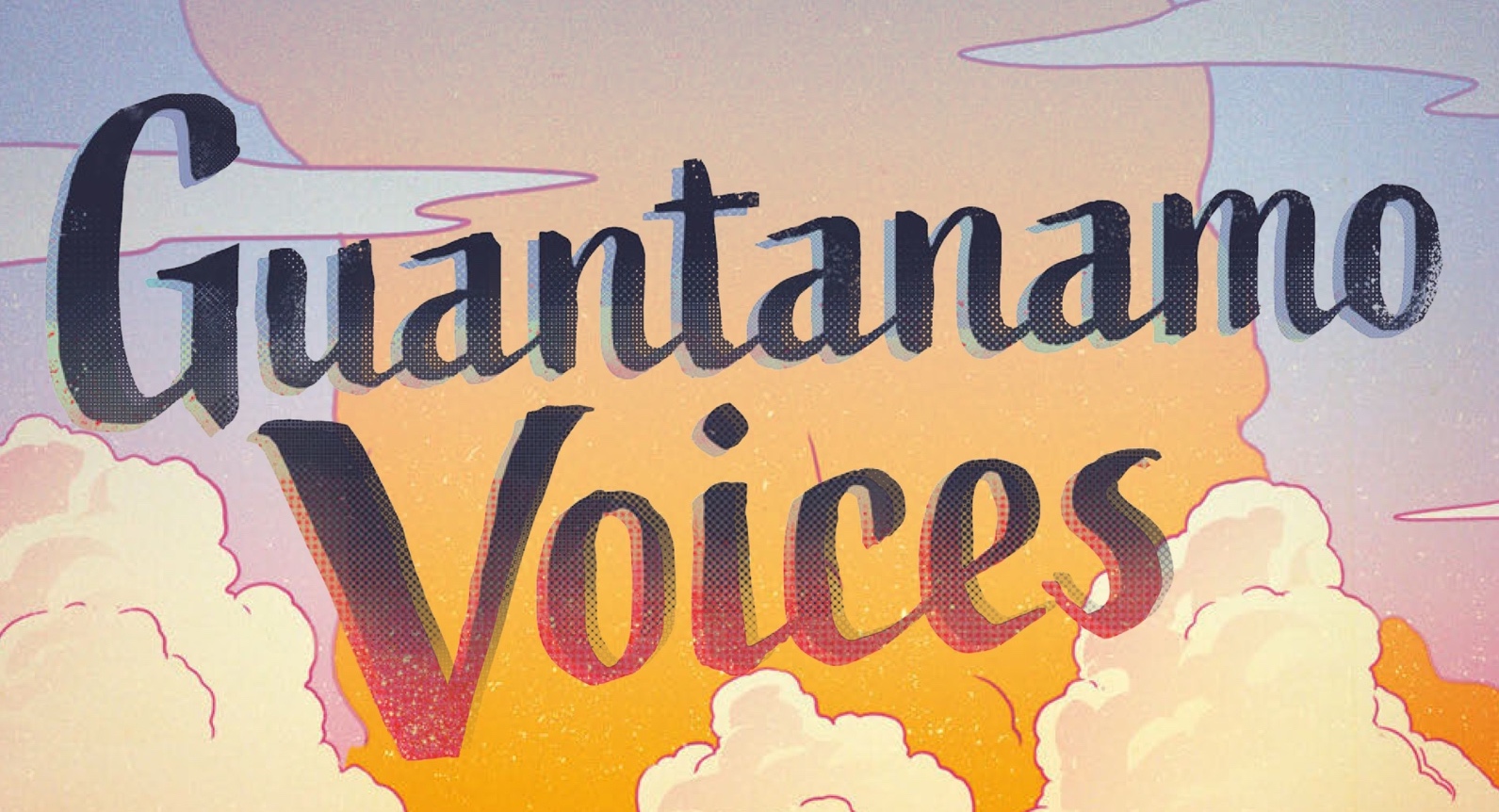When I began writing this review, U.S. Customs and Border Patrol, the largest federal law enforcement agency of the Department of Homeland Security, was kidnapping protestors on the streets of Portland, OR, where I currently live. Months previously, Ellen DeGeneres sparked controversy when she boasted about rubbing shoulders at a football game with George W. Bush. (This was before declaring that quarantining in her Beverly Hills mansion felt like being in prison.) Her response and the responses of her supporters—extolling the virtues of friendship between people who disagree politically—betray a nationwide indifference to the ongoing War on Terror, and all the atrocities committed in its name. These atrocities include the founding of the Department of Homeland Security, as well as agencies like Immigration and Customs Enforcement under its purview. Guantanamo Voices, a collection of non-fictional stories about the infamous detention facility on the U.S. Naval Station in Guantánamo Bay, offers a much-needed corrective for this collective amnesia.
Edited and scripted by Sarah Mirk and illustrated by a dozen cartoonists, Guantanamo Voices is based on interviews with prisoners, workers, lawyers, and advocates whose lives have been permanently affected (to put it mildly) by their experiences with the Guantánamo prison, also known as GITMO. Starting from the early days of the War on Terror and moving through to the present day, Guantanamo Voices deftly paints an impressionistic portrait of an obscured, ever-elusive subject, bringing to light the absurd cruelties of GITMO and the legal sleight-of-hand that enables its continued existence.
Guantanamo Voices is, frankly, an incredible book. Not only is it extremely thoroughly researched—the citations alone would probably take me months to read through—it also brilliantly exemplifies the power of comics journalism. Comics can pack a whole book’s worth of text, visual information, and emotional nuance into just a few pages, making it an excellent medium for presenting complex topics in an approachable way.
I was initially drawn to Guantanamo Voices because I’m always hungry for any relatively current information about Cuba, or additional pieces of its history. Cuba is fascinating to me not only because my maternal grandparents—whom I sadly don’t know well—immigrated from there; it’s also irresistibly interesting as a socialist nation right in the United States’s backyard, made enigmatic by the blockade that prevents communication between Cuba and the U.S. Growing up in Miami, I was aware of the Guantanámo prison’s existence, but never understood how the U.S. managed to run a base on the island that we blockaded and treated as a dangerous enemy.
The introductory sections, illustrated by Nomi Kane, provide a very helpful overview to get the reader up to speed with the basic facts of Guantánamo. In them, I learned that the U.S. Naval Station was established in 1903, in a lease agreement with Cuba that has no expiration date—an early example of the control that the U.S. government would continue to hold over the nation until the Cuban revolution in 1959. After the revolution, Fidel Castro demanded the land back, but of course, that never happened. Instead of packing up and moving out, starting in 1961, the U.S. government planted thousands upon thousands of landmines around the base, which weren’t removed until 1999. Due to the literally interminable lease agreement, the $3,386 annual rent on the land hasn’t changed since 1903. I was surprised to find out that the U.S. sends Cuba a rent check every year: the Cuban government, in turn, refuses to cash it every time. The prison we now know as GITMO began as temporary refugee camps in the 90s. Camp Delta, where 41 people are still imprisoned, was completed and opened to hold War on Terror prisoners in April 2002.
Not unexpectedly, the Cuba facts mostly end there; after all, Guantanamo Voices is, by definition, not about Cuba. As the map at the beginning of the book illustrates, the Guantánamo Naval Station and the prison it encloses is very much United States territory, right down to the McDonald’s and the Irish pub. This political reality, which is so absurd that it feels like it should be fiction, is very much at odds with the physical reality of the land it squats upon. GITMO, the stronghold, resists our attempts to study, understand, and dismantle it; meanwhile, Guantanamo Bay makes itself known in the giant iguanas strolling on the far side of a barbed wire fence, in the image of the ocean through a hole in the wall that a prisoner can’t forget, and even in the comics’ colors, chosen to evoke a Caribbean sunset.

What I did end up learning a lot more about was the War on Terror, particularly its early days. I was in middle school when the September 11 attacks and subsequent declaration of war took place. I understood little of what was going on, and grew up in a conservative family with unshakeable faith in the promise of American democracy. I was scared of the idea of war, but trusting of the government, and skeptical of peers and adults whose criticisms sounded, to my naive sensibilities, like conspiracy theories.
In fact, the actions actually carried out by the Bush administration were just as wild as any conspiracy. Before reading Guantanamo Voices, I didn’t know, for example, that the military air-dropped thousands of flyers in rural Afghanistan, offering cash rewards of up to $5000 to locals who turned in suspected terrorists. An alarming majority of the people imprisoned at GITMO during the War on Terror appear to have been captured this way, or in civilian raids based on weak information. Nor did I know that the vast majority of people imprisoned at GITMO—including those still there—were never actually charged with any crime.
The prisoners at Guantánamo are instead designated as “unlawful enemy combatants,” a legal status which is only applied to non-U.S. citizens, cooked up by the U.S. government to justify war crimes and indefinite detention. Any Americans suspected of terrorism were and are tried in federal courts, while “enemy combatants” face military tribunals. Prisoners released from Guantánamo without ever facing charges retain this “enemy combatant” status, meaning that many of their own countries will not take them back, requiring a “sponsor” country to take them in instead. Even after release, these people cannot return to their families and friends: in other cases, they have nowhere to go because in the years since their imprisonment, their home cities and countries have been razed to the ground by the “Forever War.” Even from the vantage point of 2020, I find it bone-chilling how a handful of words in a politically-motivated U.S. policy could displace and dehumanize hundreds, almost a thousand men, on a literal whim.
The most striking thing about Guantanamo Voices, however, is not the wealth of information it offers, nor even the skillfully assembled narrative that makes an endless, illegal war somewhat legible. What Sarah Mirk and her team of cartoonists excel at is humanizing the participants of the story, particularly the prisoners who have endured every sort of dehumanization imaginable. And though it does also draw out the humanity of those who work within the system—a Naval officer who leaks secret information about prisoners to a lawyer, a Guantánamo Bay staffer who practices Taoism and loves punk music—the book doesn’t seek to rehabilitate anyone responsible for war crimes, nor allow those simply functioning as a cog in the great imperialist machine to escape questioning. Instead, it demands that we examine whatever it is that allows human beings to rationalize the cruelties that we inflict in the name of security.
My favorite story—or more accurately, the story that haunts me most profoundly—is in chapter seven, illustrated by Kane Lynch. It’s the story of Mansoor Adayfi, a Yemeni man who was one of the earliest men imprisoned in Guantánamo in 2002, and not released until 2016. In 2003, Adayfi and his fellow prisoners befriend a family of rats, even feeding them crumbs of food; later, they discover that the guards have been macing the rats. Adayfi and his cellmates berate the guards for this pointless cruelty, throwing water on them from their cell toilets. The guards respond with predictable brutality, pepper spraying the prisoners in turn, and delivering punishments like solitary confinement and cut meals. Of the experience, Adayfi simply says: “When you have so little, you must stand for what you have and defend those who have less and are weaker. Even if they are a banana rat.”
Guantanamo Voices is extraordinary and deeply important work that ties the brutality of our present to the depravity of the not-so-distant past. It raises more questions than it is capable of answering, and indeed, ends on a distinct note of uncertainty and profound discomfort. In the middle of 2020, as protestors all over the United States are struggling to imagine and create just systems of care and rehabilitation, Guantanamo Voices reminds us that this struggle goes far beyond our own borders. I think of the 41 humans stolen from their homes, caged on an occupied territory that barely exists, some of whom may never see the outside world again, and I wonder: will we allow this exceptional moment to expand our compassion on a mass scale, and demand more not just for this country, but for the entire world? Will we ever dare to make amends?

Guantanamo Voices is due out on September 8, 2020. You can pre-order a copy from your preferred retailer through the Abrams Books website, here.




